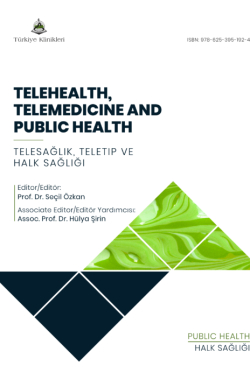Telemedicine in Internal Medicine Sciences
Özden SEÇKİN GÖBÜTa , Maide Gözde İNAMb
aGazi University Faculty of Medicine, Department of Cardiology, Ankara, Türkiye
bColumbia University Vagelos College of Physicians and Surgeons, Department of Ophthalmology, New York, USA
Seçkin Göbüt Ö, İnam MG. Telemedicine in internal medicine sciences. In: Özkan S, ed. Telehealth, Telemedicine and Public Health. 1st ed. Ankara: Türkiye Klinikleri; 2024. p.77-80.
ABSTRACT
Telemedicine is the use of electronic information and communication technologies in the delivery of health care. Telemedicine applications enable overcoming geographical barriers and providing health care in a much wider area with limited resources. Following the COVID-19 pandemic, telemedicine has regained prominence due to its associated benefits, resulting in an increased utilization. It is thought that its use is effective in internal medicine fields, which are at the forefront due to the majority of non-invasive diagnosis and treatment methods. It significantly reduces hospital admissions and lowers costs for both patients and health institutions. It also allows all individuals to receive quality health care regardless of regional differences. However, on the other hand, it also creates a significant disadvantage by not offering a comprehensive physical examination opportunity. Furthermore, it raises unresolved questions within the realms of privacy, ethics, and malpractice laws. In this chapter, it is aimed to discuss the use of telemedicine in internal medicine sciences and its potential advantages and disadvantages.
Keywords: Telemedicine; internal medicine; teleradiology; telerehabilitation
Kaynak Göster
Referanslar
- Ohannessian R, Duong TA, Odone A. Global Telemedicine Implementation and Integration Within Health Systems to Fight the COVID-19 Pandemic: A Call to Action. JMIR Public Health Surveill. 2020;6(2):e18810. [Crossref] [PubMed] [PMC]
- WHO. Telemedicine: opportunities and developments in member states. Report on the second global survey on eHealth: World Health Organization; 2010.
- Ryu S. Telemedicine: Opportunities and Developments in Member States: Report on the Second Global Survey on eHealth 2009 (Global Observatory for eHealth Series, Volume 2). Healthc Inform Res. 2012;18(2):153-5. [Crossref]
- Barneveld Binkhuysen FH, Ranschaert ER. Teleradiology: evolution and concepts. Eur J Radiol. 2011;78(2):205-9. [Crossref] [PubMed]
- Gitlin JN. Teleradiology. Radiol Clin North Am. 1986;24(1):55-68. [Crossref] [PubMed]
- Kalender N, Özdemir L. Yaşlılara Sağlık Hizmetlerinin Sunumunda Tele-Tıp Kullanımı. Anadolu Hemşirelik ve Sağlık Bilimleri Dergisi. 2014;17(1):50-8.
- Molinari G, Molinari M, Di Biase M, Brunetti ND. Telecardiology and its settings of application: An update. J Telemed Telecare. 2018;24(5):373-81. [Crossref] [PubMed]
- Backman W, Bendel D, Rakhit R. The telecardiology revolution: improving the management of cardiac disease in primary care. J R Soc Med. 2010;103(11):442-6. [Crossref] [PubMed] [PMC]
- Ertek S. Endokrinolojide tele-sağlık ve tele-tıp uygulamaları. Acıbadem Üniversitesi Sağlık Bilimleri Dergisi. 2011(3):126-30.
- Aba N, Tel H. Diabetes mellituslu hastalarda depresyon ve özbakım gücü. Cumhuriyet Hemşirelik Dergisi. 2012;1(1):18-23.
- Shirke MM, Shaikh SA, Harky A. Tele-oncology in the COVID-19 Era: The Way Forward? Trends Cancer. 2020;6(7):547-9. [Crossref] [PubMed] [PMC]
- Doolittle GC, Harmon A, Williams A, Allen A, Boysen CD, Wittman C, et al. A cost analysis of a tele-oncology practice. J Telemed Telecare. 1997;3 Suppl 1:20-2. [Crossref] [PubMed]
- McCord C, Bernhard P, Walsh M, Rosner C, Console K. A consolidated model for telepsychology practice. J Clin Psychol. 2020;76(6):1060-82. [Crossref] [PubMed] [PMC]
- Rosen MJ. Telerehabilitation. NeuroRehabilitation. 1999;12(1):11-26. [Crossref]
- Litscher G. Modernization of traditional acupuncture using multimodal computer-based high-tech methods-recent results of blue laser and teleacupuncture from the Medical University of Graz. J Acupunct Meridian Stud. 2009;2(3):202-9. [Crossref] [PubMed]
- Botsis T, Hartvigsen G. Current status and future perspectives in telecare for elderly people suffering from chronic diseases. J Telemed Telecare. 2008;14(4):195-203. [Crossref] [PubMed]
- Ahring KK, Ahring JP, Joyce C, Farid NR. Telephone modem access improves diabetes control in those with insulin-requiring diabetes. Diabetes Care. 1992;15(8):971-5. [Crossref] [PubMed]
- Bensink M, Hailey D, Wootton R. A systematic review of successes and failures in home telehealth: preliminary results. J Telemed Telecare. 2006;12(3_suppl):8-16. [Crossref]
- Dansky KH, Palmer L, Shea D, Bowles KH. Cost analysis of telehomecare. Telemed J E Health. 2001;7(3):225-32. [Crossref] [PubMed]

